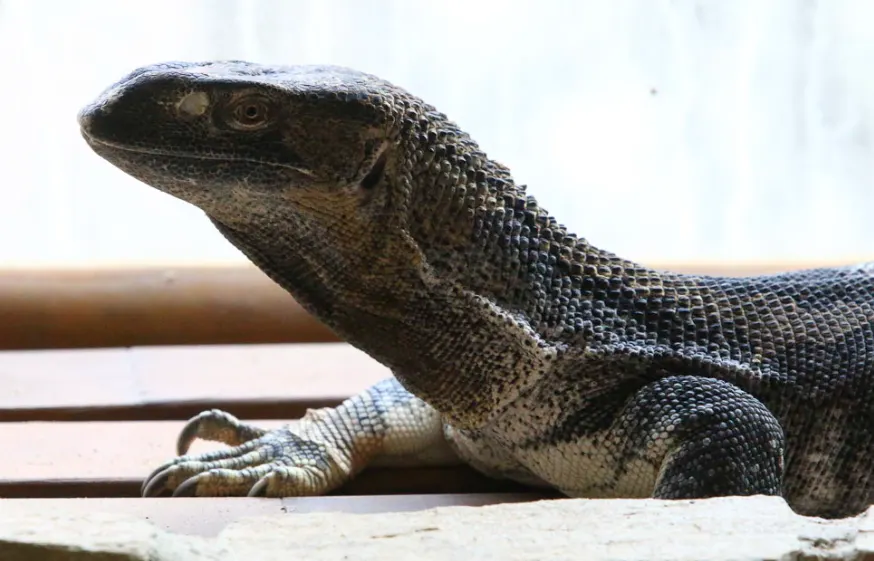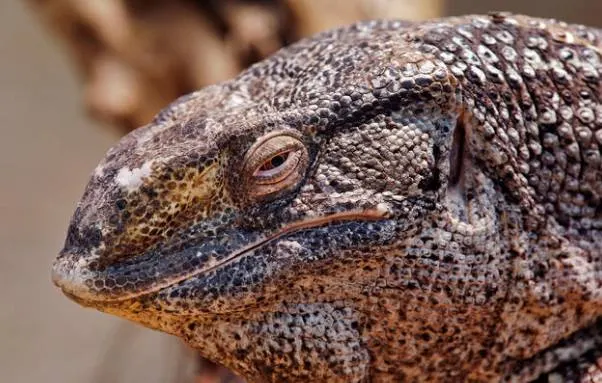The black-throat monitor, scientifically known as Varanus albigularis microstictus, is an awe-inspiring reptile that holds the title of the largest lizard in Africa by mass. This remarkable creature, known for its impressive size and unique characteristics, captivates the interest of reptile enthusiasts and researchers alike.
Table of Contents
Scientific Classification
- Kingdom: Animalia
- Phylum: Chordata
- Class: Reptilia
- Order: Squamata
- Family: Varanidae
- Genus: Varanus
- Species: Varanus albigularis microstictus

Conservation Status
The black-throat monitor is classified as “Least Concern” by conservationists, indicating that the species currently faces no imminent threat of extinction.
Habitat and Distribution
Native to East Africa, the black-throat monitor can be found in arid regions across Tanzania, Somalia, Burundi, Ethiopia, and Kenya. They thrive in hot, dry environments such as savannas, prairies, and steppes. Unlike some other monitor species, they do not inhabit rainforests or true deserts.
Physical Characteristics
Black-throat monitors are known for their massive size. Adults can grow up to seven feet in length and weigh over 60 pounds. They exhibit a color palette ranging from dark greyish-brown to tan, with yellowish or white markings that blend well with their natural surroundings. These markings form mottled patterns that vary between individuals, often becoming less distinct as the lizards age.
Their most distinctive feature is the dark patch of scales on their throat, which gives them their common name. They possess serrated teeth, sharp claws, and powerful tails, which they use for defense. These lizards also have a forked tongue, which they flick to sense their environment, much like snakes.
Behavior and Lifestyle
Black-throat monitors are diurnal, meaning they are active during the day. Juveniles spend much of their early life in trees to avoid ground predators, but as they grow larger and more formidable, they transition to a terrestrial lifestyle. Despite their intimidating size, black-throat monitors are known to be relatively docile when raised in captivity. They are intelligent and can even recognize and interact playfully with their human caretakers.
These lizards are solitary creatures, primarily burrowing underground or hiding under rocks in their natural habitat. In captivity, they require spacious enclosures with ample opportunities for climbing and burrowing.
Diet
As obligate carnivores, black-throat monitors feed exclusively on animal matter. In the wild, their diet includes rodents, other reptiles, birds, and insects. They are opportunistic feeders, consuming both live prey and carrion. In captivity, their diet must be carefully managed to include a variety of prey animals such as lizards, snakes, large insects, and fish. It is crucial to dust insects with calcium supplements to prevent metabolic bone disease, a common health issue in captive monitors.
Reproduction
Reproduction in black-throat monitors typically begins at the onset of the dry season. After mating, the female lays her eggs in damp soil or within termite mounds to maintain the necessary humidity and temperature. Clutch sizes can exceed 30 eggs, which hatch after an incubation period of 116-180 days, coinciding with the rainy season to ensure an abundance of
Captivity and Care
Black-throat monitors can make fascinating pets for experienced reptile keepers. They require large, well-ventilated enclosures with space for climbing and burrowing. Regular human interaction is essential to keep them docile and prevent aggression. Their slow metabolism means they do not need daily feeding, but their diet must be carefully monitored to avoid obesity and nutritional deficiencies.
Frequently Asked Questions (FAQs)
Q: Are black-throat monitors dangerous?
A: Black-throat monitors can be dangerous if threatened or provoked, especially in the wild. They possess sharp teeth, claws, and powerful tails. However, when properly handled and socialized in captivity, they are generally docile and friendly.
Q: Are black-throat monitors venomous?
A: Yes, black-throat monitors possess venom, but it is not fatal to humans. It is primarily used to subdue small prey.
Q: How long do black-throat monitors live?
A: Black-throat monitors have a lifespan of about 25 years in captivity when properly cared for.
Q: What do black-throat monitors eat?
A: In the wild, they consume a variety of prey, including rodents, other reptiles, birds, and insects. In captivity, they are typically fed a diet of lizards, snakes, large roaches, insects, chicks, crustaceans, and fish.
Q: Can black-throat monitors be kept with other pets?
A: It is not advisable to keep black-throat monitors with other pets. They are large and may view smaller animals as prey.
Q: How big do black-throat monitors get?
A: Black-throat monitors can grow up to seven feet in length and weigh over 60 pounds, making them the largest lizard in Africa by mass.
Q: Are black-throat monitors good pets for beginners?
A: No, black-throat monitors are not recommended for beginner reptile keepers due to their size, specific care requirements, and potential for aggression if not properly handled.

Q: Do black-throat monitors need special housing?
A: Yes, they require large enclosures with ample space for climbing and burrowing. Proper ventilation, temperature control, and hiding spots are also essential for their well-being.
Q: How do black-throat monitors defend themselves?
A: Black-throat monitors use their serrated teeth, sharp claws, and powerful tails as defensive weapons. When threatened, they may hiss, puff up their bodies, and lash out with their tails.
Q: Where can black-throat monitors be found in the wild?
A: Black-throat monitors are native to East Africa, primarily found in Tanzania, Somalia, Burundi, Ethiopia, and Kenya. They inhabit arid regions such as savannas, prairies, and steppes.
In conclusion, the black-throat monitor is a fascinating and formidable reptile with unique characteristics and specific care requirements. While they can make interesting pets for experienced keepers, they are not suitable for beginners. Their impressive size, distinctive appearance, and complex behaviors continue to captivate reptile enthusiasts and researchers worldwide.
- Enchi Ball Python: A Unique and Stunning Morph of Python regius - March 27, 2025
- Emerald Tree Monitor: The Enigmatic Green Guardian of the Rainforest - March 26, 2025
- The Egyptian Cobra (Naja haje): A Fascinating Serpent - March 25, 2025
